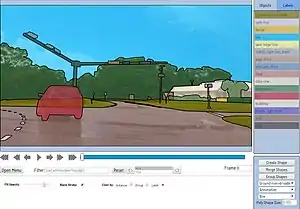Computer Vision Annotation Tool
Computer Vision Annotation Tool (CVAT) is a free, open source, web-based image and video annotation tool which is used for labeling data for computer vision algorithms. CVAT was developed for use by a professional data annotation team, with a user interface optimized for computer vision annotation tasks.[2] Try it online cvat.org.
 CVAT version 1.2.0 | |
| Developer(s) | Intel |
|---|---|
| Initial release | June 29, 2018 |
| Repository | github |
| Written in | JavaScript, CSS, Python, HTML, Django |
| Operating system | Windows 7 or later, OS X 10.11 or later, Linux |
| Available in | English (US) |
| Type | Image and video annotation tool |
| License | MIT License[1] |
| Website | cvat |
CVAT supports the primary tasks of supervised machine learning: object detection, image classification, and image segmentation. CVAT allows users to annotate data for each of these cases.[3]
CVAT has many powerful features, including interpolation of shapes between key frames, semi-automatic annotation using Deep Learning models, shortcuts for most critical actions, a dashboard with a list of annotation projects and tasks, LDAP and basic access authentication, etc.[4]
CVAT is written mainly in TypeScript, React, Ant Design, CSS, Python, and Django. It is distributed under the MIT License, and its source code is available on GitHub.
See also
- List of manual image annotation tools
- VoTT
- Image annotation tools on GitHub
- Annotation tools for building datasets
- Getting Started with CVAT - Annotation for Computer Vision
- Best Open Source Annotation Tools for Computer Vision
- Four Important Computer Vision Annotation Tools you Need to Know in 2020
- Image Annotation Tools: Which One to Pick in 2020?
References
- "LICENSE". github.com/opencv/cvat. Intel.
- "Intel open-sources CVAT, a toolkit for data labeling". VentureBeat. 2019-03-05. Retrieved 2019-08-13.
- "Computer Vision Annotation Tool: A Universal Approach to Data Annotation". software.intel.com. 2019-03-04. Retrieved 2019-08-13.
- User's guide of Computer Vision Annotation Tool, OpenCV, 2019-08-13, retrieved 2019-08-13